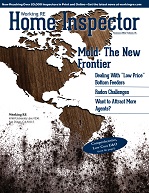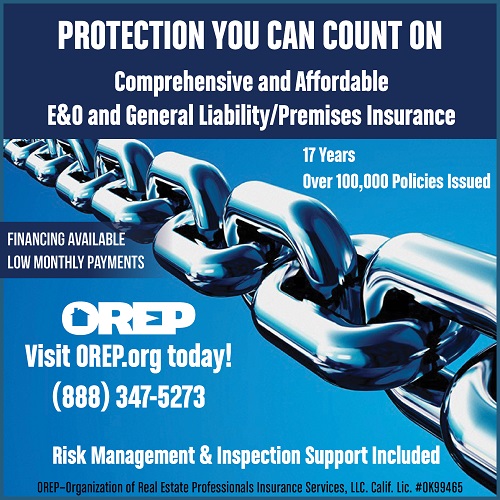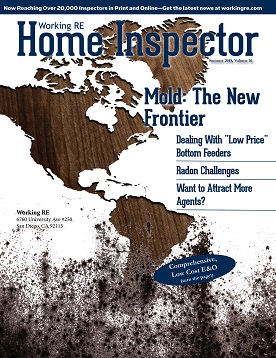 |
> E&O/GL Insurance for Home Inspectors Competitive Rates, Broad Coverage, Free Risk Management, online inspection support for tough questions, discounts on education and more… Professional Coverage, Competitive Pricing Shop OREP today! |
Mold: The New Frontier
by David & Jenn Sherwood, SherwoodInspection.com
Like the many issues that came before it, testing for mold is becoming a routine part of a home inspection. And it’s not without precedent.
If you go back to the 1970s and early 80s, termite inspections became an easy way to kill a real estate transaction, until the home services community produced solutions to termite infestations that were reasonable and accessible to buyers and sellers alike. Once a solution was provided, termite infestations stopped having such an extreme impact real estate transactions.
Twenty years later, radon gas became the new hot-button issue. Home inspections that tested for radon and found high levels could easily kill a pending real estate transaction. Agents and homeowners were cynical about radon to begin with, since it was not well-known at the time and is not detectable to humans. Some agents refused to use home inspectors who recommended radon testing to their clients for fear of losing the deal.
Much like the termite issue, the home services community started developing cost-effective and efficient solutions to high radon gas levels. In addition to the increase in accessibility of viable options for mitigation, education of the real estate community and the general public increased the awareness of radon gas, the impact it can have on health and the solutions that exist. After a time, radon stopped being a deal-killer and is now a fairly common test offered by home inspection companies around the country and other parts of the world. Next up is mold.
Mold Testing
Nowadays, recommending a termite inspection or radon test in conjunction with a home inspection is fairly status quo and unlikely to cause ill will from real estate agents. There is, however, a remaining point of contention between inspectors and agents in the world of environmental testing recommendations. “Mold” is the new four letter word that can cause potential homebuyers panic and their agent’s frustration (to put it nicely). This often scares off many inspectors from offering it as a service. Mold is the new deal killer.
When I started performing inspections back in 1982, many people questioned my decision to go into the business. People told me that the liability associated with performing home inspections was too high, and the reward too low. At that time, only about 20 percent of real estate transactions involved a home inspection. Based on that information, and the potential risk in an industry where one big mistake could sink a small business, the odds of creating a successful and profitable company in the home inspection industry were low.
Of course those naysayers were mistaken. Over 90 percent of today’s real estate transactions involve a home inspection. The industry has shifted and we are slowly becoming more comfortable with change as an industry. Sometimes the change is slow but it happens. What’s more, the increase in information accessible to the general public through the Internet has forced many real estate agents to get on board with environmental testing because their clients are more knowledgeable and are demanding such testing be performed.
The question, then, is not whether mold testing will become an accepted part of the home inspection industry– it already has. The question is how inspectors can handle mold testing and remediation recommendations to best serve their business, their clients and real estate agents. This, of course, generates additional questions for inspectors as they consider whether to add mold testing as a service, or if they already offer it, how best to operate the mold testing side of their business in order to produce the best possible outcome for all parties involved. What are those questions? Let’s look at a few.
(story continues below)
I do not currently test for mold. Should I add mold testing to my business?
For home inspectors who are not testing, this is not so much a question as it is the question. Some inspectors have already decided that the answer for them is “no,” and that is unlikely to change. These inspectors do not want to test for mold and will not consider it as an option. Why? Some cite the possible liability associated with it, while others are not convinced that mold is an issue worth addressing – the data that exists on mold’s impact on health and homes has not convinced this group that mold is truly an issue. Other inspectors refuse to consider mold testing simply because they fear that even mentioning mold testing as an option will anger their agent base and ultimately cost them business if those agents stop using them. There also are inspection companies that offer mold testing but are frustrated by roadblocks or issues they encounter with sampling or the follow up required after testing is completed.
Ultimately it is impossible for me to say whether mold testing is right for you and your company, only you can make that decision. My hope is that the information provided in this article, including the questions and answers below, will be helpful to you as you make that decision.
Can I truly help my clients by offering to perform a mold test in conjunction with a home inspection?
The short answer is: YES! Absolutely. The slightly longer answer is yes, however, the help you provide is determined by the scope of the work. We believe that testing should be done only when there is some indication that mold might be present. The testing then provides information that will support or refute the visual red flag.
Fixing the Problem
Determining the scope of a mold issue is perhaps the single most impactful way you can help your clients. Determining the scope of the issue is more than identifying whether mold is present, it includes identifying possible sources of moisture. All too often a client is told that a mold problem exists, they spend a large sum to have the mold removed, and they never address the underlying water issue. If the moisture intrusion is not fixed, the mold issue will come back. Pointing out moisture intrusion issues for your clients provides them with a helpful resource to ensure that they are tackling the entirety of the issue, not just fixing a symptom (mold) and ignoring the cause.
Proper Protocol
To best serve your clients, it is imperative that you follow industry standards and best practices for sampling follow the IESO (Indoor Environmental Standards Organization) Volume I Mold sampling standards. For more information Google IESO or ACAC.
Does Testing for Mold Increase my Liability?
Limiting your liability is a matter of ensuring that you have a clear and comprehensive contract that clearly identifies your limitations as an inspector, as well as what you are and are not doing, evaluating and reporting on in a home. In addition to a strong contract, ensuring that you have the proper training, have obtained and maintain any license(s) that might be required in your state, and that you provide a clear report to the client that reiterates its limitations, are all ways in which you can limit your liability as a home inspector. Adding mold evaluation and/or testing as a service, provided those other items are in place, should not impact the level of your liability. To say that you don’t want to do mold testing because of an increase in liability is like saying you don’t want to inspect the roof of a home because you are concerned with liability. Sounds silly, doesn’t it?
More than 80% of the mold-related lawsuits occur as a direct result of the inspector not offering mold testing to their client, and failing to mention red-flags for mold that were apparent during the inspection.
Why should you consider adding this service? Over 90 percent of the Realtors polled in a recent survey said that they did believe that home inspectors should inspect for mold as part of a home inspection. In addition, 90 percent of homebuyers when polled, stated that they thought that a standard home inspection should include identification of possible mold growth even if it is excluded in the home inspection. (For details on these polls go to http://nathan.tv/HomeInspectionSurvey.)
Should inspectors be on the lookout for mold or issues that might lead to mold in every inspection, even if their contract specifically excludes it?
Yes! Visible signs of possible mold growth are a red flag for the presence of a past or current water intrusion issue somewhere in the home. Most sources of water intrusion are a result of failures in one or more of the systems that an inspector should evaluate during a home inspection, which means that inspectors should be identifying those issues wherever possible. One way to write your contract would be to say “although the inspector will look for warning signs indicating the presence of things like mold, we cannot see behind surfaces, stored items, or other items blocking access to any area of the home. During our inspection, we are looking for visible signs of…” and go from there.
On an inspection, when you point out that there is a “mold-like growth” or “microbial-type growth,” or whatever language you choose to use in your report, you’re leaving a time bomb of sorts in the hands of both your client and their agent. The only way to determine with certainty whether a “red flag” area is in fact mold, is to take a sample (or multiple) and have those samples analyzed by a third-party lab or to suggest the client hire a third party to do so.
Let’s say that you or another professional provide mold testing. You take samples, send them to a lab for analysis, and the lab sends you a report. Now what? One of the problems you may run into is that many lab reports are not designed to be end-user friendly. In other words, your typical client or Realtor® is not going to have the background knowledge and general information base to interpret those results and make informed decisions on the property based on those results.
Oftentimes, all a lab report indicates is where the samples were taken and what the results of those samples are, be it an air sample or positive/negative for mold presence on a surface (note: not all labs will use the same terminology). If the lab report includes only basic information and does not include any analysis, your client and the agent may not be any better off than they were before samples were taken. Many inspectors stop here and recommend the services of an expert.
However, there are companies that have the expertise and provide analysis on what sample results mean, as well as recommended next steps. If the report you provide to the agent and homeowner contains that information, it is yet another way to stand out among your competition and truly serve the needs of your clients.
Providing the information they need oftentimes helps save the deal because the client sees the next steps and can anticipate the cost and time involved in dealing with the problem, instead of panicking.
Whatever mold testing you offer as part of a home inspection, it is imperative that you inform the client clearly about what the testing is and is not going to accomplish. Mold testing, even in conjunction with a home inspection, may not answer all of the questions that are present. In the majority of cases you will be performing what is called “limited mold testing,” meaning that you are only investigating and sampling in one or maybe a few small areas of the home that have red flags present.
In some cases, this testing will not be sufficient to determine the source or scope of a mold issue and more investigation will be necessary. In other cases, limited mold testing will be sufficient, especially in conjunction with the findings of the home inspection, to provide the information needed by the agent, client, and other parties involved in the transaction to ensure that they know what next steps need to be taken.
The best way to ensure that the highest possibility of resolution is achieved is to adhere to the following four steps:
1. If you find mold growth, identify any water issues that may have caused it, whenever possible. Like any aspect of your inspection there will be limitations to your ability to see all possible sources; however, with thorough investigation you can, at the very least, rule out a number of items and point your client in the right direction for next steps (i.e. consult a plumber).
2. Sample for mold following industry best practices so that the client and other parties involved are clear whether red flags that were visible during the inspection are, or are not, mold.
3. Provide information regarding methods of remediation, what protocols should be followed, or what best practice would be ideal for this situation. If at all possible, have a professional remediation company ready to refer.
4. Recommend to the client that follow-up testing, often known as “post-testing,” be performed to ensure that no further presence of elevated mold is found.
Post Testing
Many inspectors, even those who provide mold testing, are not familiar with testing as clearance for remediation and tend to shy away from it because it requires specific training and can result in increased liability. The solution for home inspectors who want to provide mold testing, and do so in a way that their clients and agents can get the most meaningful answers from it, is to work with a lab that provides analysis and recommendations within the reports that are prepared for the client. This takes a burden off the home inspector who might be asked to interpret the report himself, while providing useful and actionable information to the inspectors’ clients.
If you want to increase the value you offer as a home inspector, while also increasing your revenue, then mold testing might be for you. Home inspectors who are interested in mold testing need to seek out quality education where they can learn about the characteristics of mold, the ways in which mold can negatively impact an individual’s health, how to perform testing and what the sampling protocols are, and what equipment is needed to perform quality mold testing.
When researching industry resources, look for one that will not only help train you but can provide you support when you have questions. Any inspector knows that one of the most time-consuming parts of a home inspection comes after the report is delivered, when the client and/or agent calls with questions. Adding mold testing will increase the number of those questions but they can be handled by an intermediate company that acts as the liaison between you and the client or agent.
The question we started with at the beginning of this article is whether or not you should do mold testing with your inspection services if you don’t already. Now we can see that the real question is how to add/perform mold testing to increase profitability, reduce liability and provide the highest quality and most helpful information to your clients and agents to assist them in the home buying/selling process and ensure that the deal goes to closing. The answer is to provide a full service product including testing analysis, high grade reporting and walking through the recommendations.
Free Risk Management Online Course Claims and Complaints: How to Stay Out of Trouble
Available Now
Presenter: David Brauner, Senior Insurance Broker OREP
David Brauner, Senior Broker at OREP, shares insights and advice gained over 25+ years of providing E&O insurance for inspectors, showing you how to protect yourself and your business. Watch Now!
About the Author
David and Jennifer Sherwood are a father and daughter team teaching mold classes. David has been a home inspector since 1982 and has a very successful home inspection company in New England. David also teaches for the EPA. His daughter Jenn runs a successful mold remediation company in Maryland in her own right. Both have a wealth of knowledge in the mold arena. Visit their website at sherwoodinspection.com.
Note: The Summer 2019 issue of Working RE Inspector is mailing now to over 20,000 home inspectors nationwide. OREP Insureds enjoy guaranteed delivery of each print magazine and many more benefits.
OREP Appraiser E&O insureds enjoy it free and this year Free Approved Continuing Education!!




by Michael Rhodes
Excellent article. I have 13 years experience in mold testing and remediation as well as home inspections. I have been shunned by agencies in the past for reporting on mold even though it is expressly mentioned in the home inspection portion of the buyers agreement. This has, over time, lead the best agents and agencies to recommend our services. Remember, inspections are to protect the clients and the agents. Too bad more of them don’t realize this fact.
-